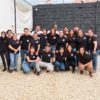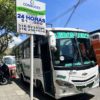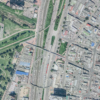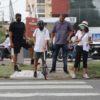As part of our work with ONU Habitat to support improvements in non-motorized transport in the Metropolitan Area of the Aburrá Valley (AMVA), we implemented—alongside the regional government—a Safe Route to the World Urban Forum that improved conditions for those arriving to the Forum on bicycle and beyond.
To carry out the Safe Route pilot project, we sought to demonstrate good practices and build confidence and support among interested groups. In addition, we attempted to offer effective support for the city of Medellin and the metropolitan region, in promoting cycling through the development of a Metropolitan Master Plan for Cycling, consistent with the existing urban mobility policies in the region. The final objective of the plan was to counter the detrimental effect of increased motorization and promote the use of non-polluting modes of transport, like the bicycle.
The growing use of the private automobile and especially motorcycles (representing 51% of Medellin’s circulating vehicle fleet) in the capital of Antioquia and the towns that make up the Aburrá Valley (Caldas, La Estrella, Envigado, Itagüí, Sabaneta, Bello, Copacabana, Girardota, Barbosa) has made traffic flow in these municipalities much less efficient.
On the other hand, it has demonstrated fully that one of the most efficient and sustainable modes of transport is the bicycle, given that they don’t consume fuel, require little road space, and create little risk compared with motor vehicles, in addition to the health benefits (Pucher & Buehler 2012). Many cities around the world (from Europe to North America) have implemented policies that promote bike use and these have shown positive impacts on the economy, society and environment of a city.
Keeping this in mind, it is necessary to guarantee and prioritize citizens’ access to the use of sustainable transport modes, through efficient and economical measures.
On January 23 of this year, Despacio carried out a workshop with AMVA and EnCicla, in which we analyzed the different possibilities of connection were discussed in two stages: i) Information analysis and ii) Physical examination. The meetings that were held with AMVA, the Secretariat of Culture, bicycle users, among others, to determine the best option for the WUF pilot project. It was decided that the Route should be developed along the Calle San Juan. As this is a high-traffic road, it was essential to divide the cyclist from cars and after many discussions, it was decided that the best option was to place flowerpots along the route.
Once the decision was taken for the Calle San Juan pilot project, we needed to involve key stakeholders to make the route as good as possible. Different organizations showed their total support for the initiative while others feared potential consequences, especially for the movement of cars on Calle San Juan. These types of reactions were expected; therefore we had some strategies with certain criteria and arguments that could convince actors that had significant influence and in some way showed little interest in the pilot project. Some of the arguments in favor of the Safe Route presented to these high-influence low-interest actors are presented below:
Large event: mobility plans at large events (World Cup, Olympics) and in this case the 7th World Urban Forum promote the use of public transport, walking and cycling to get to events. It is more efficient and uses less urban space. In addition, in this case it promotes the Forum’s initiative: cities for life. And what better city for life than one that promotes and supports public and non-motorized transport and that furthermore prioritizes these modes over private transportation?
International Participants: The international participants were going to use public and non-motorized transport during the event, not cars. A large number of taxis with the Forum logo were made available, but the taxis had to comply with prerequisites (vehicle model 2010 or more recent, not have any debts or fines with the affiliated taxi company, among others). Many visitors favored these taxis, knowing they were in a safe vehicle. However, given the number of people expected at the WUF, taxi service was insufficient and for a foreigner, it can be slightly difficult and complicated to take a public bus. The other options were the Metro and Metroplus system, which is generally efficient, fast and safe, as well as near the Plaza Mayor (where the conference took place). It was also necessary to offer people another option, like cycling to the event location. For this, we held a management session with private entities to offer a place to park bicycles.
Car parking: The Plaza Mayor did not have parking spaces set up during the Urban Forum. Due to UN regulations, Plaza Mayor’s parking spaces couldn’t be used during the forum, mainly for security reasons. This obviously reduced the demand to get to the venue.
Security: Calle San Juan already has bike users, independent of the safe route’s existence. Having this road exclusively for bicycle users could actually increase ridership in addition to providing greater security to those who pass through this area.
International Community: In recent years, Medellin has been recognized for its innovative initiatives (awarded the most innovative city) and projects aimed at achieving greater equity and development in the city: Metrocable, electric staircases, public parks and plazas, libraries in low-income areas, among others. This is especially so for all those wanting to come and get to know the thriving and progressive city that has received so much recognition internationally, including notably the sustainable transport award, precisely due to bike promotion.
It was the Secretariat of Mobility’s request: In various meetings in 2013, the Secretariat of Mobility requested UN Habitat’s work on bicycles be carried out. This is the result of long-term dedicated work on how to improve mobility for the WUF and thinking about what it would be like after the forum.
Going through the divider: Access to the divider implies an intervention anyway and reduces the road capacity but it has the negative effect of creating risks for cyclists entering and leaving the divider.
These were some of the main arguments given to stakeholders to get their authorization to implement the Safe Route. While all this was underway, Despacio continued its task of carrying out the activity to be conducted in a public space, hoping there would not be delays or sudden changes in the route that had already been designed.
The Safe Route
The initial route had a path of less than 2 km but due to permissions restrictions from the Medellin’s Secretariat of Mobility, the route was cut back to just one kilometer.
The decision to put flowerpots was an important issue for the physical appearance of the Route. There were fears about the route’s potential appearance with these flowerpots. At first, we thought of placing about 250 flowerpots but after doing some research about costs, models, materials, durability, etc. of the flowerpots and due to restrictions from the city and budgetary concerns, we decided to install just over 50 flowerpots along the kilometer of divided road.
Once the route was defined, it was necessary to strategically place the 50-plus flowerpots in a way that maintained real separation from cars but was also visually appealing. After many visits to the location and various calculations, it was decided to strategically place flowerpots in groups of four throughout the route.
At first we had the idea of painting just the flowerpots but given that there would be bollards as part of the route as well, we decided to give color to this cold and dreary urban equipment. And as a new space to be given to the community, it was necessary to indicate that the bike route is a shared space for different people and forms of non-motorized transport. We designed a stencil to indicate who could use this space.
It is important to include community participation as a stakeholder within whatever process, and more so if it affects community members in a direct way. It was necessary to awaken the interest of people who could be important and active players. For this reason, we called on the community to attend our event to decorate and paint the urban space. Leaflets were designed and handed out to people inviting people to accompany us on March 30, 2014 for a day of party and picnic in a public space (“Picnic Parque del Río”). We also held a successful campaign on social media outlets. The community was invited not only to paint but also to enjoy the picnic and claim a space for themselves on the road to define the Safe Route to the WUF. Parque del Río collaborated in the design and distribution of invitations.
The construction of the Safe Route took place through the following actions:
– Distribution of materials along the intervention zone
– Physical segregation of the bike route on Calle San Juan
– Painting the flowerpots that would be part of the separation.
– Intervention into the existing physical infrastructure on Calle San Juan such as the confinement walls of the planters and bollards.
– Planting flowers and other plants in the flowerpots on Calle San Juan.
– Artistic intervention with the flowerpots in the existing infrastructure (some of the painted messages were “more love, less motor” “We don’t fight, we bike”)
In total, 78 flowerpots were installed, distributed strategically so that they would remain as close as possible to their permanent location after the intervention’s completion. Participants in this activity were very responsible in using the material, so there was no unnecessary or unplanned expense from painting that negatively affected the landscape of Calle San Juan. They followed the given instructions very well regarding the distribution of colors along the route.
After the activity ended March 30th, we began circulating information about the bike route and its use in adjoining areas connected by the route. In Laureles, a hotel and restaurant area, we shared informational fliers that gave visibility to the Safe Route, offering mobility alternatives to get to the Plaza Mayor. This activity including the participation of AMVA officials, the Despacio team and a number of volunteers, using materials designed by Despacio and other materials produced by AMVA. In addition to distributing fliers on motorized and non-motorized vehicles around the intervention zone, we installed a street banner with information about the Safe Route to advertise the route in a more permanent way to passersby.
During and after the intervention of March 30, we held 10 conversational interviews (Valles, 1992) of which 4 were recorded with informal verbal consent of the interviewee. These were chosen circumstantially, where we had rapport with the individuals and the situation lent itself to an interview. These took place on March 30th, the day of citizen participation in the construction of the bike lane on the Calle San Juan (during the intervention) and in the Plaza Mayor, in the bike parking area installed for the Safe Route.
Another key actor in the effective implementation of the Safe Route was the police and area guards. With the support of AMVA in contacting them, we held brief trainings Thursday April 3 and Friday April 4 in conjunction with the AMVA team. The trainings were held by AMVA and Despacio staff. The information given to the police agents and guards was:
– The location and path of the bike route
– Support for the Safe Route
– Distribution of maps of the Safe Route
– How to guarantee the safety of pedestrians and cyclists: not to prohibit bike use but rather go slowly and respect pedestrians as the protagonist of the road.
A diversity of international organizations with knowledge of the Safe Route proposal, showed their support through communiques sent to Medellin’s Secretariat of Mobility. The goal in doing so was for entities with transport expertise to give legitimacy to the proposal.
To understand the functioning of the Safe Route, the benefits generated and the bicycle journeys attracted, we performed field measurements as a complement to this project, in order to have a detailed technical analysis. Despacio came to an agreement with the Universidad de los Andes to carry out an analysis. The main objective of the university in the Safe Route project is to understand how traffic behaves on a high capacity route (Calle San Juan) when a lane is closed to motor traffic. Using different equipment and tools at the university, one can prove technically the positive impacts the Safe Route has on mobility in Medelllin, in terms of air quality, a reduction in greenhouse gases, a reduction in bicycle accidents, an increase in bicycle modal share, a reduction in travel times, congestion, etc.
Bike Parking in Plaza Mayor
We also completed a bike parking project in the Plaza Mayor. Its representative showed outstanding interest in the project, proposing a unique, unconventional design for bicycle parking that would emphasize the uniqueness and innovativeness of the business. We mentioned the possibility of making it in the shape of a car, which caught their attention, and they decided to produce their own outline of a car as part of the first group of bike parking in the area.
(For more information, look up the hashtag #Rutasegurawuf7 on Facebook and Twitter). There also a few posts on blogs about this topic (one on the Interamerican Development Bank and another from Pardo in El Tiempo), and even videos!








Comentarios recientes